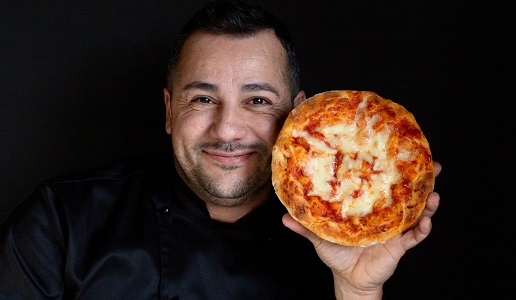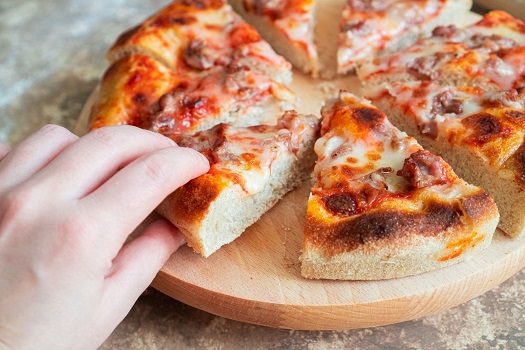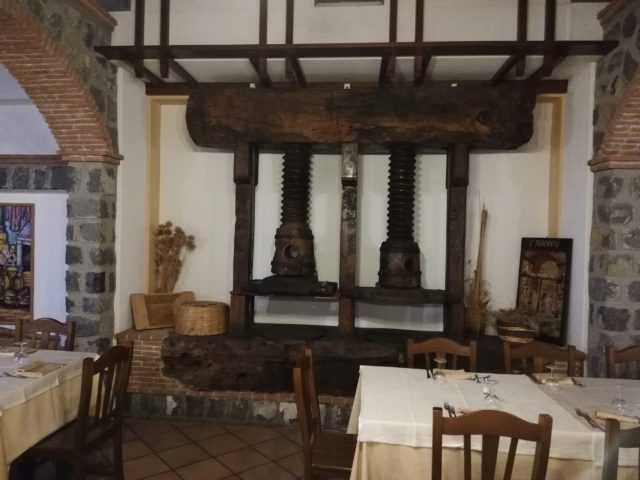Spaniza-mania has broken out

As soft as bread, as fragrant as pizza, organic and highly digestible thanks to Grani Alti, Francesco Gigliotti's creation has conquered Emilian palates and is ready to arrive throughout Italy and beyond.
Everyone is crazy about Spanizza, or a new way of eating pizza. Taking its cue from the Bolognese slang word "spanizzo," which indicates a person who knows his or her stuff, master baker Francesco Gigliotti's creation, which began as an experiment in 2020 and quickly became a must-try throughout Emilia Romagna.
The fluffiness of bread combined with the crispness of pizza, organic flours from Grani Alti e Antichi, sourdough, and products from the local area: these are the winning ingredients of Spanizza, born in the midst of a pandemic.
"We were all cooped up in the house, people to pass the time made bread and pizza, but at a certain point you couldn't even find yeast in supermarkets anymore," recalls Francesco Gigliotti. "Even the delivery system had gone haywire due to too many requests, the pizzas arrived home cold and very late. Hence we came up with the idea: to prepare quality, low-impact bases for Bolognese people to take home, to be completed in their own oven with the ingredients of their liking. We wanted to create a healthy, highly digestible product thanks to the use of 100% organic flours from Grani Alti, a new gastronomic experience that could bring a little lightness at a difficult time for everyone."
Of necessity virtue. And so Spanizza, in a pan, in a pan, or in the form of a ball of raw dough to be rolled out and seasoned, began to arrive in the homes of the Bolognese. A success that grew amidst the difficulties of the pandemic situation, which in a short time, thanks to the appreciation found in the city, evolved and spread throughout Emilia Romagna through the partnership with the Camst Group. From Ravenna to Forlì, from Parma to Imola, Spanizza can now be enjoyed in many Tavola Amica outlets, as well as in the heart of Bologna, at the Centrale Gastronomica restaurant. A healthy, incredibly digestible product that eliminates the age-old problem of thirst after pizza, it is also affordable for everyone, thanks to a cost set between 5.50 and 7 euros.
From 500 creations produced on an experimental basis for the Bolognese in 2020, this has grown to more than 200,000 doughs sold throughout the territory in 2023, while the goal for 2024 is set at 1 million pieces. The first Spanizze have already begun to "trespass the territory of origin, landing in the Marche region, and in the new year Gigliotti, who has become the "guru of Grani Alti," plans to take his creation to many other regions of Italy and abroad. His products on the other hand have already crossed the border and have been appreciated in several outlets in Switzerland for the past few months.
High Grains, the "magic" ingredient of Spanizza
 The ingredient that makes panizza so tasty and special is Grani Alti. Fascinating Francesco Gigliotti about the properties of this exceptional product was a meeting with Giovanni Dinelli, a full professor at the Department of Agri-Food Sciences and Technologies at the University of Bologna, and in particular the BIOADAPT project, which was created to promote regional organic cereal farming through the recovery and enhancement of ancient soft wheat accessions. The flour used in Spanizza is obtained from the Oroset evolutionary population, developed just as part of the BIOADAPT project, obtained by reciprocally crossing five varieties of High and Ancient grains with high size: Andriolo, Frassineto, Gentil Rosso, Inallettabile, and Verna.
The ingredient that makes panizza so tasty and special is Grani Alti. Fascinating Francesco Gigliotti about the properties of this exceptional product was a meeting with Giovanni Dinelli, a full professor at the Department of Agri-Food Sciences and Technologies at the University of Bologna, and in particular the BIOADAPT project, which was created to promote regional organic cereal farming through the recovery and enhancement of ancient soft wheat accessions. The flour used in Spanizza is obtained from the Oroset evolutionary population, developed just as part of the BIOADAPT project, obtained by reciprocally crossing five varieties of High and Ancient grains with high size: Andriolo, Frassineto, Gentil Rosso, Inallettabile, and Verna.
"High Grains were cultivated for about 8,000 years, then, with technological progress after World War II, synthetic fertilizers, pesticides and pesticides were introduced into agriculture. This led to the abandonment of the cultivation of High Grains," says Giovanni Dinelli professor of Agronomy at the University of Bologna, "in favor of new, selected varieties of low-crop wheat, which are able to respond positively in productive terms to the new nitrogen fertilizers. At the same time, the quality of their gluten was changed: the new low-cut wheats also had to provide a flour that could adapt to the new kneading technologies, which required a "strong" gluten that could withstand mechanical stress. That's why Spanizza made with High Grains, has a gluten that is of a different quality: it is weaker than modern grains and this makes the final product much more digestible."

 Italiano
Italiano








